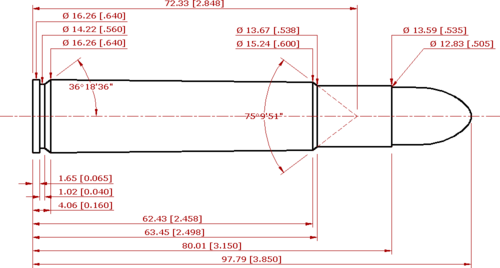| 505 Gibbs | ||||||||||||||||
|---|---|---|---|---|---|---|---|---|---|---|---|---|---|---|---|---|
 | ||||||||||||||||
| Type | Rifle | |||||||||||||||
| Place of origin | England | |||||||||||||||
| Production history | ||||||||||||||||
| Designer | George Gibbs | |||||||||||||||
| Designed | 1910 | |||||||||||||||
| Manufacturer | Gibbs | |||||||||||||||
| Produced | 1911 | |||||||||||||||
| Specifications | ||||||||||||||||
| Parent cartridge | none | |||||||||||||||
| Case type | Rimless, Bottleneck | |||||||||||||||
| Bullet diameter | .505 in (12.8 mm) | |||||||||||||||
| Neck diameter | .538 in (13.7 mm) | |||||||||||||||
| Shoulder diameter | .600 in (15.2 mm) | |||||||||||||||
| Base diameter | .640 in (16.3 mm) | |||||||||||||||
| Rim diameter | .640 in (16.3 mm) | |||||||||||||||
| Rim thickness | .065 in (1.7 mm) | |||||||||||||||
| Case length | 3.150 in (80.0 mm) | |||||||||||||||
| Overall length | 3.850 in (97.8 mm) | |||||||||||||||
| Case capacity | 178 gr H2O (11.5 cm3) | |||||||||||||||
| Rifling twist | 1 in 16 (406 mm) | |||||||||||||||
| Primer type | .254/Kynoch#40/Large Rifle | |||||||||||||||
| Maximum pressure | 39,160 psi (270.0 MPa) | |||||||||||||||
Ballistic performance
| ||||||||||||||||
|
Test barrel length: 24" Source(s): Norma [1] & MidwayUSA [2] | ||||||||||||||||
The 505 Gibbs cartridge was designed by George Gibbs in 1911. The cartridge was originally known as the .505 Rimless Nitro Express or simply as the .505 Rimless. CIP refers to the cartridge as the 505 Mag. Gibbs in their publications. It is a .50 caliber (12.8 mm) rimless bottlenecked cartridge intended for magazine rifles.
General Information
The .505 Gibbs has a case capacity of 178 grains (11.5 g).[3] This cartridge was originally loaded with 90-grain (5.8 g) of cordite and 525-grain (34.0 g) bullet at 2,300 ft/s (700 m/s) for 6,166 ft·lbf (8,360 J) of kinetic energy.[3] While the .505 Gibbs has a greater case capacity than most modern cartridges, it is loaded to lower pressures.[3] The C.I.P. recommends a pressure standard of 2,700 bars (39,160 p.s.i.) for the cartridge.[4] As .505 Gibbs was intended for hunting dangerous game in a tropical environment and due to the temperature sensitivity of cordite the lower pressures provided a greater safety and reliability margin.
The .505 Gibbs has a unique bullet diameter of .505 in (12.8 mm) while most other .50 caliber bullets have diameters of .510 in (13.0 mm). Barnes Bullets and Woodleigh Bullets are a few of the bullet manufacturers who produce component bullets for reloading in this caliber. Woodleigh Bullets does not recommend impact velocities of over 2,250 ft/s (690 m/s) for their .505 caliber 525 gr. Weldcore bullets.[5]
Premium dangerous game rifle manufacturers, such as Hartmann & Weiss (Hamburg, Germany) and Westley-Richards (Birmingham, UK) build expensive but thoroughly reliable .505 Gibbs rifles on Mauser 98 actions. Ceska Zbrojovka (CZ) currently manufactures the Safari Classics rifle[6] for this cartridge. Doumoulin Herstal SA of Belgium offers the cartridge in their White Hunter model.[7] Modern semi-automatic rifles are also available in this cartridge from Vigilance Rifles.[8]
As of 2013, Norma, Nosler and Kynoch are offering loaded ammunition in 505 Gibbs. Excellent bullets are available from Cutting Edge Bullets, Woodleigh Bullets, and North Fork Bullets.
Design & Specifications
The .505 Gibbs is one of the most voluminous cases designed. The large volume was required as the cartridge was designed to burn cordite as its propellant. CIP has published specifications for the cartridge.
The CIP requires that a barrel have 5 grooves, twist rate of a bore Ø of one revolution in 406 mm (16.0 in), a bore Ø of 12.55 mm (0.494 in) and a groove Ø of 12.80 mm (0.504 in) with each grove measuring 5.33 mm (0.210 in) wide. The recommended pressure for the .505 Gibbs is 2,700 bar (39,000 psi).
Sporting Use
The .505 Gibbs is a niche cartridge, designed for hunting heavy, dangerous game, such as elephant, cape buffalo and grizzly bear.
In Literature
The cartridge's claim to fame was its use by the fictional character, Robert Wilson, the hunter of Ernest Hemingway's short story The Short Happy Life of Francis Macomber.
See also
- Hartmann & Weiss
- .408 Chey Tac
- .338 Xtreme
- .500 Jeffery
- .500 Nitro Express
- .500 No. 2 Express
- .577/.500 Magnum Nitro Express
- .577 Tyrannosaur
- .50 BMG
- List of rifle cartridges
- 12 mm caliber
References
- ↑ Norma Ammunition
- ↑ MidwayUSA
- ↑ 3.0 3.1 3.2 http://www.huntnetwork.net/modules/wfsection/html/505magnum.pdf
- ↑ CIP
- ↑ "Bullet Specifications, Dimensions & Details". Woodleigh Bullets. Archived from the original on 3 July 2010. http://web.archive.org/web/20100703071336/http://www.woodleighbullets.com.au/index.php/bullet-lists/traditional/468q-700q. Retrieved 12 August 2010.
- ↑ http://cz-usa.com/products/by-brand/safari-classics/
- ↑ "White Hunter". dumoulin-herstal.com. Dumoulin Herstal. 2004. http://www.dumoulin-herstal.com/en/white_hunter.htm. Retrieved 9 December 2010.
- ↑ http://www.vigilancerifles.com/
- Current African Cartridges: The 505 Gibbs
- Barnes, Frank C. (2006) “505 Gibbs” Cartridges of the World 11th Ed.Iola WI. Skinner p. 403
External links
- AccurateReloading.Com on the 505 Gibbs
- http://www.norma.cc/en/Products/Hunting/505-Magnum-Gibbs/
- Vigilance Rifles - makers of the only semi-automatic rifle chambered in 505 Gibbs
- Current African Cartridges: the .505 Gibbs
The original article can be found at .505 Gibbs and the edit history here.
